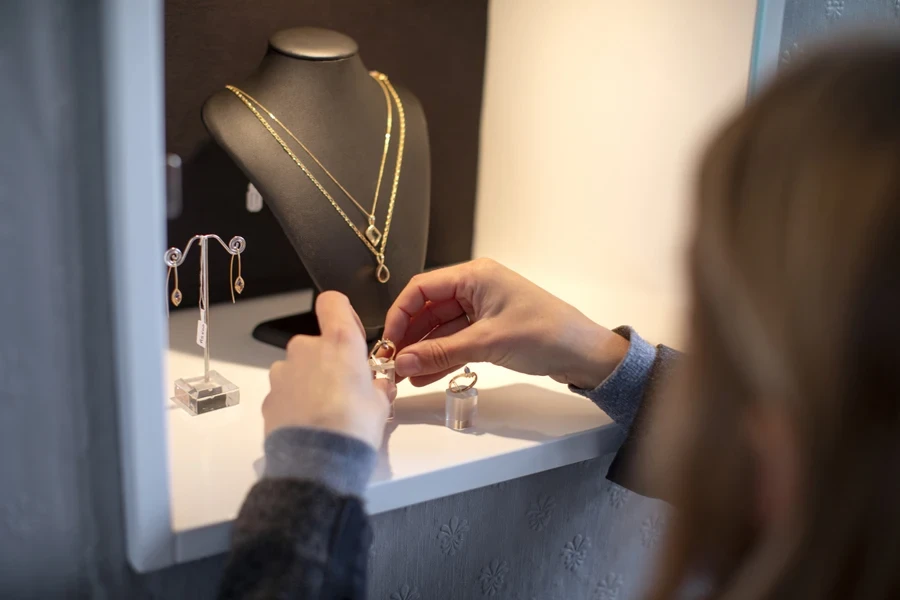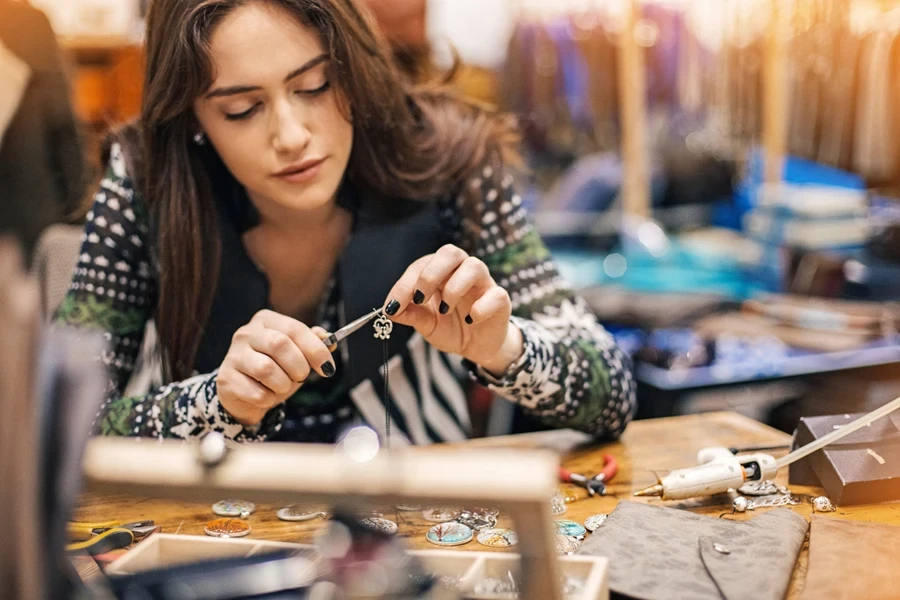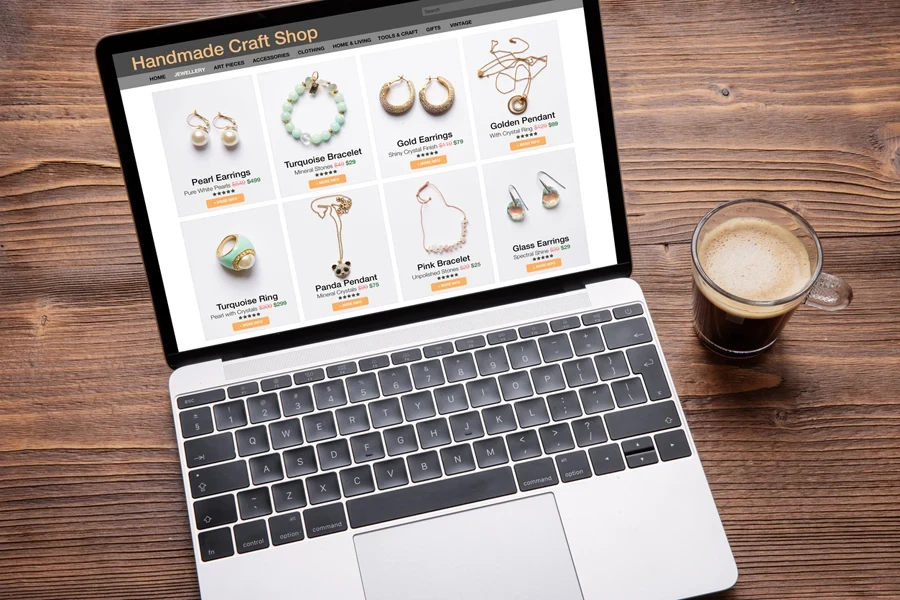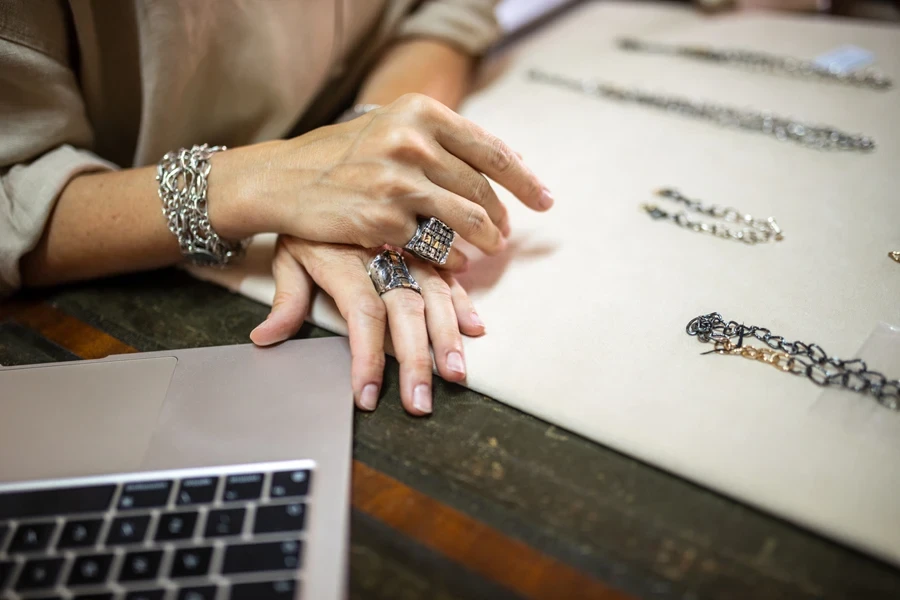Jewelry making is a relaxing way for many creatives to unwind after a busy day. But what happens when their designs start catching the eye of friends or even strangers? They might wonder: “Could I turn this hobby into a business?”
Starting a jewelry business takes some industry know-how, but here’s an exciting fact: the jewelry market is growing fast. Experts say the global jewelry market will reach USD 46.3 billion by 2028, meaning there’s more than enough room for newcomers.
The market may be especially profitable for entrepreneurs who can carve out a niche or offer something different. So, if jewelry makers are looking to turn their passion into profit, this guide offers expert tips on how to build a successful brand from the ground up.
Table of Contents
9 steps to start your jewelry business in 2025
Start that online jewelry business today
9 steps to start your jewelry business in 2025
1. Find a great niche in the jewelry industry

The jewelry world offers endless possibilities, from playful plastic beads to high-end precious metals and gems. So, one of the first things future owners must figure out is what kind of jewelry they want to sell.
They could do business with fine jewelry, costume (or fashion) jewelry, or find a middle ground. Each option has material requirements, pricing, production methods, and target customers. The main jewelry types they can choose include fine (or luxury), fashion or costume, and artist-designed jewelry.
Once future owners have picked their general category for their jewelry business, they can zero in on their niche. They can start by identifying their ideal customer. Are they classic, trendy, brides-to-be, or socially conscious shoppers? Then, determine if the jewelry targets special occasions or everyday wear. It will show owners how to market their pieces to the right audience.
Jewelry products and categories
Next, future owners should consider whether to focus on various jewelry types or specialize in one product. They could niche down to something like engagement rings or offer a broader collection, like mix-and-match fashion pieces.
Here are some ideas for products new businesses could sell:
- Rings (adjustable or sized)
- Bracelets (bangles, cuffs, etc.)
- Engagement and wedding rings
- Toe rings, body chains, or other body jewelry
- Necklaces (chokers, pendants, etc.)
- Earrings (drop, clip-on, or studs)
- Watches
- Piercings (nose or navel)
2. Research market trends
Before new businesses build their brand and products, they must understand their audience. A good place to start is by researching trends. Monitor fashion and jewelry blogs, follow influencers, and check out popular TikTok creators to stay updated on what’s hot for each upcoming season. Looking at other jewelry designers can also spark some inspiration.
Don’t shy away from the data, either. Tools like Google Trends can show future business owners global search interest for specific terms, giving them a sense of what people are looking for and where the demand is. Another option is to explore related trends, like the rising demand for customizable experiences (e.g., offering engraving services).
New jewelry businesses could also tap into the growing interest in sustainable shopping using ethically sourced materials. But here’s an interesting trick: they don’t always have to follow trends—new jewelry businesses can create their own. Starting a new trend can be a great way to set their business apart from the rest.
3. Define the brand

Successful jewelry businesses all share one key ingredient: a strong brand. One important thing to remember is that “brand” is different from ”branding.” The brand is about the business’s voice, mission, vision, and story—it’s how the target customers feel about the products.
Since fashion is often an emotional purchase, new brands can stand out by creating a personal connection, even starting with something as simple as the business name.
Telling the brand story and finding the voice
The new business’s brand guidelines are essential. This section should cover everything from their voice and tone to their mission and values. It’s an excellent way to stay consistent, even as the business grows. Here are some best practices new jewelry brands can follow:
- Understand the audience. How do they talk? What tone of slang would resonate with them?
- Craft a clear brand voice and tone guide.
- Share the story on the website’s “About” page.
- Make social media posts feel more personal by showing the process and inspiration behind the designs.
Brand identity, logo, and packaging
Branding involves the business’s visual elements, like the logo, packaging, websites, and business cards. Once new jewelry businesses have figured out the look and feel of their products, picked a name that connects with their audience, and identified the ideal customer, creating a cohesive brand identity becomes easier.
This step is crucial, even for small businesses, so don’t rush it. Here are some branding tasks for new jewelry business owners:
- Pick the business’s fonts, photography style, and colors.
- Build a library of brand assets, such as logo variations and design elements for packaging, social media, and the website.
- Design packaging and shipping materials that reflect the brand’s style and personality.
- Create a logo using a free online tool or hire a designer.
- Choose a memorable domain name to make it easy for customers to find the brand.
4. Produce or source the jewelry products
How new businesses make jewelry depends on design complexity, materials, price point, and skill level. To help them get started, here’s what they should know about the different production and sourcing methods.
Handcrafted jewelry production
Handcrafting unique, one-of-a-kind jewelry can be one of the most hands-on yet flexible production methods. Some techniques may require specialized training or costly equipment depending on their materials designs. New businesses may need to learn skills like soldering and weaving.
- Soldering
- Casting
- Laser cutting
- Weaving
- Silver/goldsmithing
- 3D printing
- Leather tooling
- Gemstone setting
Getting started is straightforward. New businesses can try free online tutorials to learn jewelry-making basics. As they grow, they can consider paid classes or apprenticing under an experienced jeweler to expand their skills further.
Alternatively, new businesses can focus on the creative side and outsource production to other professionals—they can even hire help. That way, they won’t need special training or equipment beyond basic tools, and their business will grow more easily.
Jewelry production: factory outsourced
New businesses can have manufacturers produce their designs instead of making the jewelry themselves. While this may not be ideal for fine or one-of-a-kind pieces, it can be a more cost-effective option for fashion jewelry in larger quantities. Generally, owners can outsource locally (for better relationships and factory oversight) or overseas (more affordable for high-volume orders).
When outsourcing, new businesses need accurate sketches or 3D renderings of their designs. Here are a few options they can consider:
- Manual tools (pencils, sketch papers, and jewelry design templates)
- General design software (Photoshop, SketchUp, and Illustrator)
- Jewelry-specific software (RhinoGold, MatrixGold, etc.)
Jewelry curation: dropshipping and resale
What if the business owner is not creative but still wants to sell jewelry? They can use dropshipping and resale to fulfill their passion. This strategy involves creating jewelry piece collections from other designers to sell or dropship.
5. Setup a studio or workspace

New businesses will need a dedicated workshop when they decide to make their jewelry in-house. Here are some things to consider when setting up a studio or workspace.
- Maneuverability: Consider how the workspace layout flows, especially if the assembly process has several steps. Can they move easily from one station to the next in a logical order?
- Safety: Some tools and chemicals used in jewelry making need proper ventilation and safety measures, So owners must ensure they check local regulations regarding these materials and processes.
- Storage: Organized storage is also important for tracking small parts, especially multi-compartment storage solutions.
Pro tip: Businesses with a larger production team or more complex needs (metalwork or silversmithing) should consider renting commercial spaces. If it’s too expensive initially, go for co-op studio spaces.
6. Take professional product photos
Product photography often determines if businesses will make sales or not. While it’s true for many businesses, it’s especially crucial for the fashion industry. New brands don’t have to break the bank for the perfect picture.
Using their smartphone, they can take fantastic DIY product photos with a simple lighting setup. Nevertheless, jewelry can be trickier to showcase because of its reflective surfaces and intricate details—but that’s solvable with a few adjustments. Additionally, new businesses should consider bringing in a stylist, makeup artist, or assistant.
Pro tip: Remember to showcase the products from various angles and perspectives, including product shots and lifestyle images. This will give customers a better idea of what the business is offering.
7. Build the ecommerce store

Now that new businesses have sorted out their production, photography, and branding, it’s time to pull everything together in a website. Thankfully, they don’t need an expensive, complicated website to launch their jewelry line. They can easily set up a store (like on Shopify) using a free theme and personalizing it with their brand’s fonts and colors.
8. Market the new jewelry brand
Fashion and jewelry are crowded markets, so new businesses need a solid marketing strategy to ensure their voice stands out. Remember to tailor the marketing efforts to the products, budget, and target audience. Also, jewelry businesses may have to go through some trial and error, as attracting customers will always be an ongoing goal. Here are a few ways to market jewelry brands effectively:
- Social marketing (go for a more relatable approach based on the platform instead of spamming sales pitches)
- Collabs and influencer marketing (this is a great strategy for social proof and organic marketing)
- Ecommerce SEO
- Email marketing
Pro tip: Consider experimenting with different marketing strategies to find the best results for the brand.
9. Scale! Scale!! Scale!!!

It never ends with just launching the business. New jewelry brands must work tirelessly to scale their company to better and more profitable stages. They can start by proposing designs to local boutiques before moving to larger partners as they grow. Alternatively, they can scale by entering new markets with international shipping or expanding to a wider regional audience.
Start that online jewelry business today
Entering a market as tight as jewelry can be scary initially, but new businesses don’t have to rush into it. They can penetrate the industry slowly by starting as a side gig or completing orders from their form. Starting with small-scale production helps cut off many bottlenecks—all new businesses will need is a niche, brand, and business plan. Don’t hesitate to start that dream jewelry brand today with these nine steps.




